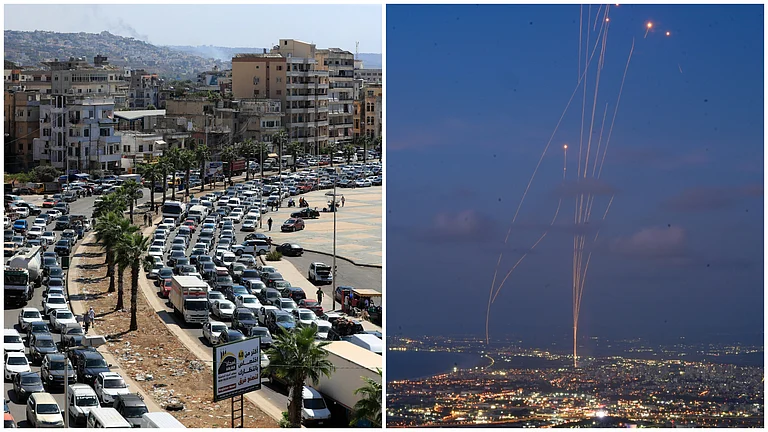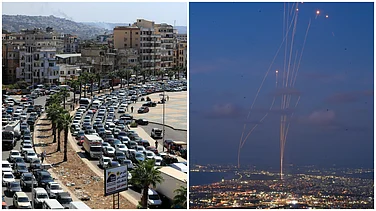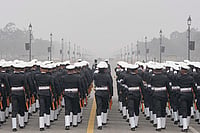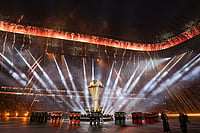There is a steady stream of people seeking to meet Dwarka Tiwari, secretary of the Gorakhnath Math, as he holds court in a room in the temple premises. Over a dozen young men with saffron scarves slung around their neck are with him. A portrait of Hindutva icon Savarkar hangs on the wall facing him. It’s a room that exudes power, symbolised by an empty desk belonging to chief minister Yogi Adityanath. Tiwari’s phone rings intermittently. He picks it up and listens patiently. When he is done, he turns to the men and women—supplicants all—who are ushered in every now and then. Tiwari has been managing the temple’s affairs, but with the assembly elections on, he has also been designated as the in-charge of the poll campaign.
The interplay between politics and religion is hard to miss in Gorakhpur—Uttar Pradesh’s other temple town, 137 km away from Ayodhya—which derives its name from saint Gorakhnath, who founded the temple. During the ongoing seven-phase polls, Gorakhnath Math, of which Yogi is the chief Mahant (priest), has become a hive of political activity. BJP workers, including members of Yogi’s right-wing organisation Hindu Yuva Vahini (HYV), have been working apace here, moving around with election materials: banners, posters, standees. “We are doing the groundwork for Maharaj ji’s record win,” says HYV state general secretary P.K. Mall, referring to the CM in the term he is addressed here.

While Yogi’s ascendancy and his aggressive comments are often cited by critics as the friction point between Hindus and Muslims, the temple’s pradhan pujari (chief priest) Kamal Nath argues that the Mahanta Digvijay Nath Trust, which manages the temple, doesn’t discriminate on the basis of religion. “It has a long history of the Hindu-Muslim amity.” The temple is widely seen as a ‘power centre’, along with Gita Press, but the priests and the trustees of the publisher insist they have nothing to do with politics. Yogi Somnath, a priest and a yoga instructor, says the temple’s efforts are in the realm of social transformation and it remains an intrinsic part of Gorakhpur’s social fabric. “The temple is the city itself,” he adds.
The Gorakhnath temple is located in the Sadar constituency, which has emerged as a hotly contested seat, primarily because Yogi is contesting his first assembly election from here. Taking the CM on in his bastion is Azad Samaj Party president Chandrashekhar Azad, who is stationed in the city for door-to-door campaigning. His party’s flags, with its kettle symbol, have added patches of blue in the saffron-dominated landscape. “Our agenda, unlike BJP’s, is pro-public. There is so much anger against Yogi because he has failed on several fronts. I come from a humble background, with no political lineage. The youth are getting impatient for a change; they can gauge what’s good for them,” Azad tells Outlook.

Also in the fray for the seat are two women—27-year-old poet and tabla player Chetna Pandey (Congress) and 55-year-old homemaker Subhavati Shukla of the SP—and a Muslim, Khwaja Shamsuddin of Mayawati’s BSP. In a region where the Thakur-Brahmin divide runs deep, the Brahmin opposition candidates could upset the BJP’s consolidated vote bank. Pandey, who worked with Yogi during her Akhil Bharatiya Vidyarthi Parishad days, says that while Azad is an ‘outsider,’ Shukla, widow of late BJP leader Upendra Dutt Shukla, has been given the ticket on compassionate grounds to garner ‘sympathy’ votes. “The Congress is fighting astitva ki ladai (the battle for existence) on behalf of the women and the marginalised,” says Pandey. The SP candidate’s campaign is being managed by her two sons, Arvind and Amit Dutt Shukla.
Voting for the nine seats in Gorakhpur assembly segment, where the number of voters is estimated to be around 4.5 lakh, will be held on March 3 in the sixth phase. Union home minister Amit Shah and SP chief Akhilesh Yadav are likely to hold roadshows for their respective candidates. Analysts say it may appear to be a multi-cornered tussle, but the main battle seems to be between the BJP and the SP. In 2018, BSP had extended support to the SP to fight against the BJP in the bypoll for the Gorakhpur Lok Sabha (LS) seat. Praveen Kumar Nishad’s spectacular streak of luck had given vigour to the SP-BSP coalition, re-energising talk of a national anti-BJP front. There was a ripple of hope among the Opposition parties at the Centre that if they were ‘united,’ it would perhaps be possible for them to stop the BJP behemoth. However, in the 2019 LS elections, that hope was dashed. The BJP and its ally Apna Dal(S) won 64 of the 80 LS seats, proving the arithmetic of the SP-BSP ‘mahagatbandhan’ in the state wrong. To add insult to injury, the Akhilesh Yadav-led SP suffered a setback: three members of the Yadav family—MPs Dimple Yadav, Dharmendra Yadav and Akshay Yadav—lost the elections.

In politics, goes the popular adage, there are no permanent friends, no permanent enemies, only permanent interests. This acquires special relevance in the political theatre of UP, where several socio-political permutations and combinations come into play every election, lending the battle at the hustings in the largest state a sense of intrigue. The Nishad (Nirbal Indian Shoshit Hamara Aam Dal) Party, which was founded in 2016 for upliftment and empowerment of the Other Backward Classes (OBCs), has joined hands with the BJP, a party dominated by upper castes, with a Thakur as the CM. Bhojpuri actress Kajal Nishad, the SP candidate from Campierganj—another traditional stronghold of the BJP where state minister Fateh Bahadur Singh, son of former CM Vir Bahadur Singh, has been a six-term MLA—says that the people of Campierganj are fighting for “freedom from misrule” of the BJP. She says: “Janta ekjut ho gayi hai (people have united). Yadavs, Rajbhars, Nishads and Muslims are together in fighting against the injustices of the Yogi government.”
In the last few years, says Gorakhpur DM Vijay Karan Anand, infrastructure of the city has been upgraded, which includes opening of AIIMS and the beautification of the lakefront. For the people of Gorakhpur, however, it’s unemployment and inflation that are the two key issues in this election. The youth this reporter met complained that there were no vacancies anywhere and they were forced to do odd jobs to get along. Even in Jungle Aurahi, the village Yogi has adopted, there are no jobs for the educated youth, they allege. While the free ration and direct benefit transfer have brought relief, it is not enough. In the Gorakhpur Rural belt, Muslims complained of “discrimination”. Vineeta Pathak, professor of political science at Gorakhpur University, says that politics has failed the people, especially those on the edge. “It’s a shame that in the 21st century, we are still talking about caste.”
Adyalal Yadav, a farmer in Campierganj, finds that inflation has made it tough for people to afford two simple meals daily. “Whatever the government has done, it is not enough. Yahan bas caste chalta ha, sona de dein to bhi nahin chalta (nothing, not even gold, works here, except caste).” Sohan Kumar of Naya Gaon doesn’t have the wherewithal to buy cylinders. “Though I get 20 kg grains, ghee aur chana (as part of the PDS), mera bartan, bichona aur vastra wahi purana hai (my utensils, beddings and clothes are the same).”

Researchers Shashank Chaturvedi, David N. Gellner and Sanjay Kumar Pandey recently wrote an essay in Contemporary South Asia, which analyses the politics of Gorakhpur since the 1920s. “Whatever happens elsewhere, Gorakhpur remains a city dominated, at least at the level of the parliamentary and MLA elections, by the Hindu Right. The increasing strength of the Math in Gorakhpur owed much to the persistent organisational efforts of successive abbots (after Mahant Avaidyanath, four-time MP from Gorakhpur) and their attempts to project themselves as progressive and developmentalist, as vikaspurush…but it also benefited, indirectly and in the long run, from the rise of gangster politics, for which the city became famous. The Math offered an alternative power centre and source of protection that was eventually able to outlast and displace the gangsters,” they write.
Sanjay Kumar Pandey, professor at the Centre for Russian and Central Asian Studies, JNU, says that the rise of the Math is linked to mafia politics of the 1960s and 1970s and its decline. “The Math has been there for a long time, but in the last 30 years, it has become unassailable. In many ways, the rise of the Math helped Gorakhpur to come out of the clutches of mafia politicians. Largely, the Math got support from the people.” Political scientists, who do not wish to be named, say that while Gorakhnath, the founder of the non-Brahmanical Nath monastic order, was anti-caste and kept himself away from the trappings of power, Yogi is not just caste conscious but also “corrupting” the tradition by demonstrating a hunger for political power. In Gorakhpur, power rests with the Math, and those who live inside it. Azad invokes Ambedkar to warn us against mixing politics with religion and creating a cult around a person. “Bhakti in religion may be a road to the salvation of the soul, but in politics, bhakti (hero worship) is a sure road to degradation.”
(This appeared in the print edition as "Temple of the King")
ALSO READ
Nawaid Anjum in Gorakhpur


























